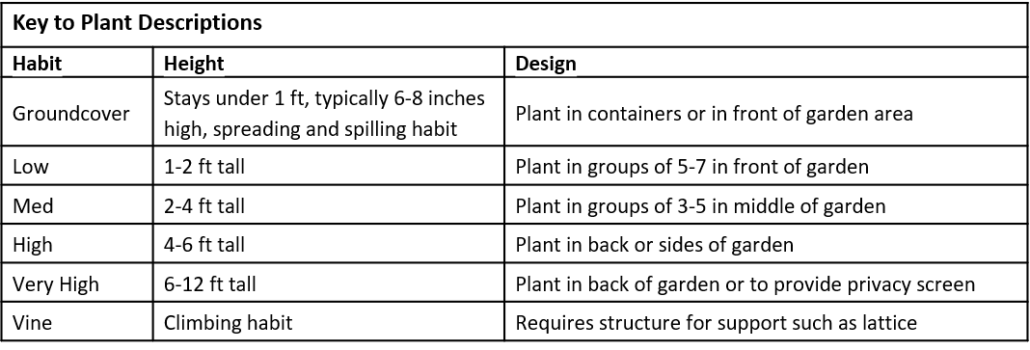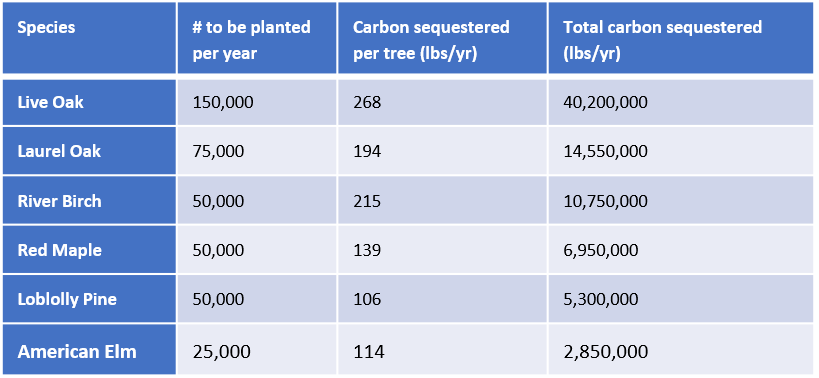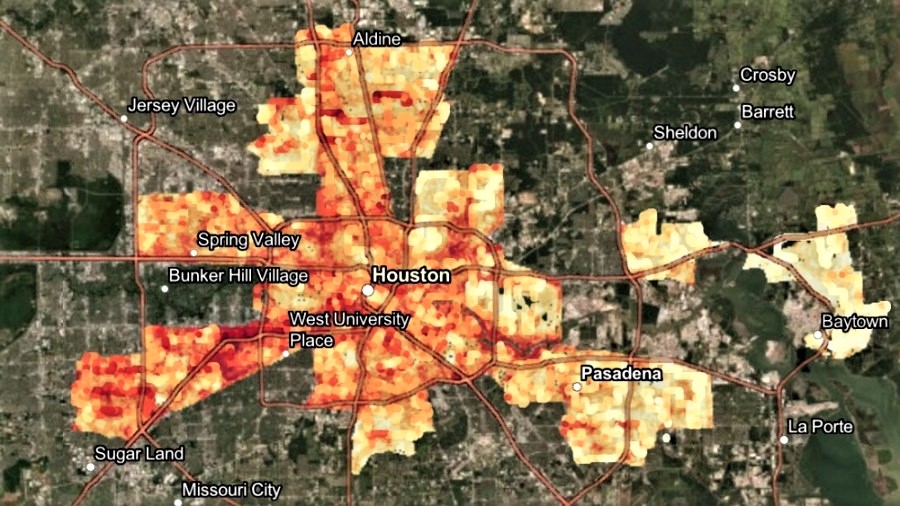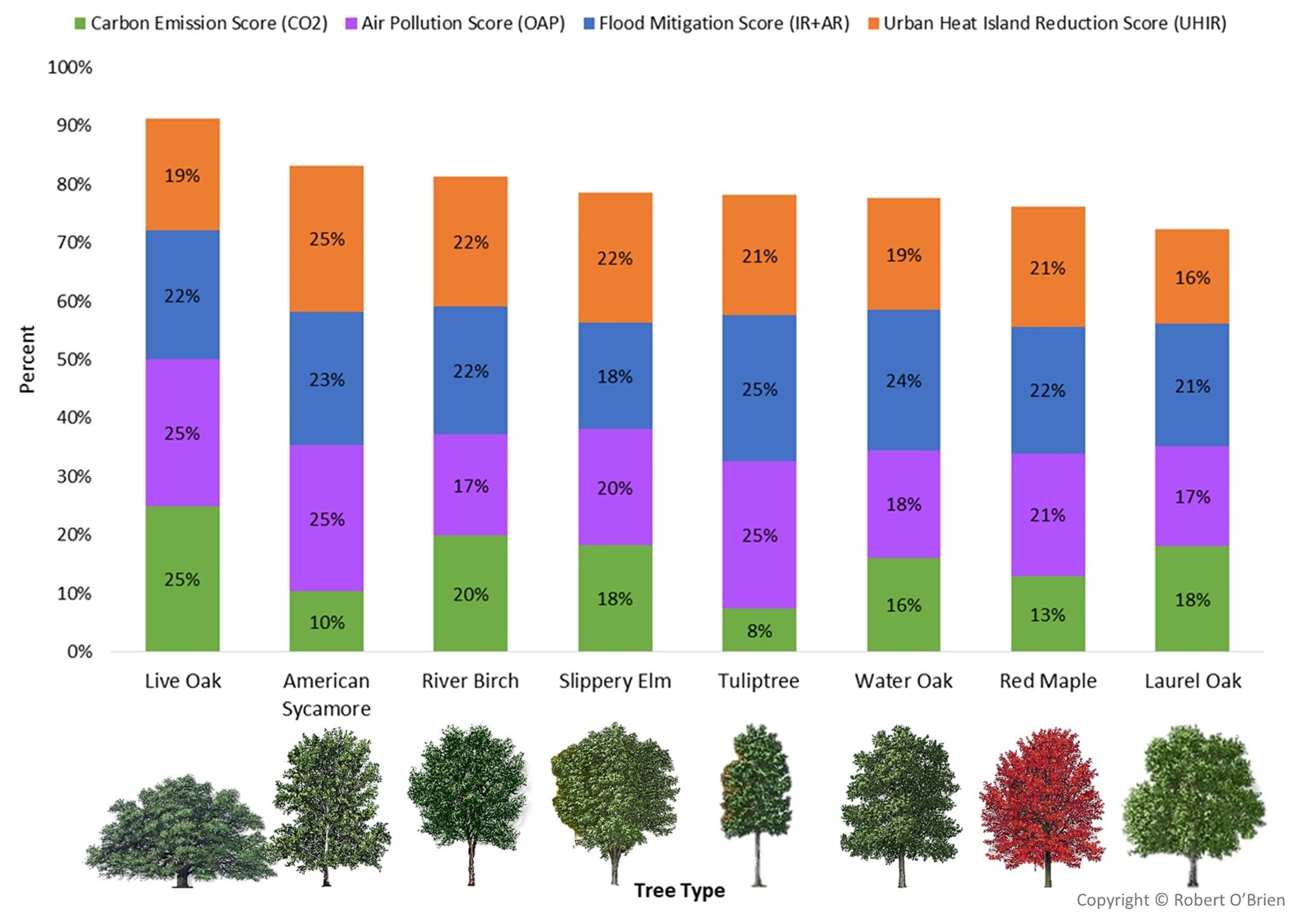Top Native Plant and Tree Lists
Here are lists of my top native plants and top native trees.
In order to make my list, a plant must have: (1) a long lasting bloom, (2) rich nectar and pollen source, and (3) drought and heat tolerance. BONUS: Hosts butterfly caterpillars such as milkweed. The plants listed are native to our Houston region; more information on native plants and trees is available under Links.
Click on the boxes below for the lists, ready to print and take to the nursery!
Top Native Plant & Tree Lists
Print Version
Tips for Pollinator Garden Design
Print Version

Top Pollinator Plants
If everyone would plant thyme and milkweed, bees and butterflies would be in a lot better situation!
Plant thyme for natural fungicide and beautiful groundcover. Rattlesnake master is difficult to find.
| Habit | Plant |
| Low | Indian Blanket (Gaillardia pulchella) |
| Low | Winecup (Callirhoe involucrate) |
| Med | Gayfeather (Liatris) |
| Med | Little Bluestem (Schizachyrium scoparium) |
| Med | All the Asters! Zinnia, Coreopsis, Echinacea, Sunflower, Rudbeckia, Yarrow |
| Med | African Blue Basil (herb) |
| Med | Texas Lantana (Lantana urticoides) |
| Med | Scarlet Sage (Salvia coccinea) |
| High | Coralbean (Erythina herbacea) |
| High | Rattlesnake Master (Eryngium yuccifolium) |
Top Hummingbird Plants
Good rule of thumb: If it’s red or orange it attracts hummingbirds.
| Habit | Plant |
| Low | Native Milkweed (Asclepias tuberosa, Asclepias viridis) |
| Med | Gayfeather (Liatris) |
| Med | Beebalm (Monarda puctata, Monarda citriodora) |
| Med | Gulf Penstemon (Penstemon tenuis) |
| Med | Scarlet Sage (Salvia coccinea) |
| Med | Drummond’s Turk’s Cap (Malvaviscus arboreus var. drummondii) |
| High | Texas Redstar (Ipomopsis rubra) |
| High | Coralbean (Erythina herbacea) |
| Vine | Crossvine (Bignonia capreolata) |
| Vine | Trumpet Creeper (Campsis radicans) |
Top Butterfly Host Plants
Plant a butterfly nursery for baby butterflies! Kids love this garden. Butterflies also love citrus trees, and garlic and onion plants.
| Habit | Host Plant | Butterfly Babies |
| Groundcover | Frogfruit (Phyla nodiflora) | Phaon Crescent, Buckeye, White Peacock |
| Low | Partridge Pea (Chamaecrista fasciculata) | Cloudless Sulfur, Orange Sulfur, Sleepy Orange, Little Sulphur |
| Low | Texas Bluebonnet (Lupinus texensis) | Cassius Blue, Marine Blue, Longtail Skipper, Spotted Skipper, Dorantes Longtail |
| Low | Winecup (Callirhoe involucrata) | Gray Hairstreak |
| Low | Native Milkweed (Asclepias tuberosa, Asclepias viridis) | Monarch, Queen |
| Med | Carrot Family (fennel, dill, parsley, rue, cilantro) | Black Swallowtail |
| Med | Yellow Wild Indigo (Baptista nuttalliana, b.alba, b.bracteata, b.sphaerocarpa) | Frosted Elfin, Wild Indigo Duskywing, Sulfurs |
| High | Southern Arrowwood (Viburnum dentatum) | Spring Azure, Henry’s Elfin |
| Very High | Indigo Bush (Amorpha fruticosa) | Silver Spotted Skipper, Southern Dogface, California Dogface, Gray Hairstreak, Hoary Edge |
| Vine | Purple Passionvine (Passiflora incarnata) | Gulf Fritillary, Variegated Fritillary |
Top Plants for Shade
You can still have a pollinator garden in shady areas.
|
Habit |
Plant |
|
Low |
Coralberry (Symphoricarpos orbiculatus) |
|
Low |
Prairie Spiderwort (Tradescantia occidentalis) |
|
Med |
Cardinal Flower (Lobelia cardinalis) |
|
Med |
Blue Mistflower (Conoclinium coelestinum) |
|
Med |
Drummond’s Turk’s Cap (Malvaviscus arboreus var. drummondii) |
|
Med – High |
Cast Iron Plant (Aspidistra elatior) |
|
High |
Fall Obedient Plant (Physotegia virginiana) |
|
High |
Big Thicket Hibiscus (Hibiscus laevis, h.lasiocarpos, h.striatus) |
|
Very High |
American Beautyberry (Callicarpa americana) |
|
Very High |
Farkleberry (Vaccinium arboretum) |
|
Vine |
Crossvine (Bignonia capreolata) |
Plant a Year-Round Buffet
Ensure there is always food available in your yard with plants that bloom during every season!
| Spring Bloomers | |
| Habit | Plant |
| Low | Texas Bluebonnet (Lupinus texensis) |
| Low | Winecup (Callirhoe involucrata) |
| Low | Pink Evening Primrose (Oenothera speciosa) |
| Med | Yellow Wild Indigo (Baptista nuttalliana, b.alba, b.bracteata, b.sphaerocarpa) |
| Small Tree | Redbud (Cercis canadensis var. texensis) |
| Small Tree | Mexican Plum (Prunus Mexicana) |
| Summer Bloomers | |
| Habit | Plant |
| Groundcover | Frogfruit (Phyla nodiflora) |
| Low | Prairie Spiderwort (Tradescantia occidentalis) |
| Med | Little Bluestem (Schizachyrium scoparium) |
| Med | Inland Sea Oats (Chasmanthium latifolium) |
| High | Rattlesnake Master (Eryngium yuccifolium) |
| Tree | Carolina Buckthorn (Frangula caroliniana) |
| Small Tree | Red Mulberry (Morus rubra) |
| Vine | Coral Honeysuckle (Lonicera sempervirens) |
| Fall Bloomers | |
| Habit | Plant |
| Med | Blue Mistflower (Conoclinium coelestinum) |
| Med | Gayfeather (Liatris) |
| Med | Seaside Goldenrod (Solidago sempervirens) |
| Med | Gold Muhly (Muhlenbergia capillaris) |
| Med | Coneflower (Rudbeckia texana, Rudbeckia hirta) |
| High | Fall Obedient Plant (Physotegia virginiana) |
| Very High | Buttonbush (Cephalanthus occidentalis) |
| Vine | Carolina Jessamine (Gelsemium sempervirens) |
Top Native Trees
Trees help humans and wildlife. Regional native tree species that are best for Houston provide: (1) Optimal carbon sequestration, (2) Air pollution absorption, (3) Water absorption (flood mitigation), and (4) Urban heat island reduction. The combined score is the Mitigation/adaptation (M/A) score.
| M/A score | Species |
| 91% | Live oak |
| 83% | American sycamore |
| 81% | River birch |
| 78% | Slippery elm |
| 78% | Tuliptree |
| 78% | Water oak |
| 76% | Red maple |
| 74% | Sweetgum |
| 74% | Black walnut |
| 72% | Laurel oak |
| 72% | American elm |
| 70% | Boxelder |
| 68% | Green ash |
| 63% | Willow oak |
| 64% | White ash |
| 57% | Black cherry |
| 53% | Loblolly pine |
| Top native tree species based on carbon sequestration (CO2 lbs/year), which depends on the growth characteristics of the tree species, the conditions for growth, and the density of the tree’s wood. | ||
| CO2 lbs/year | Species | |
| 268 | Live Oak | |
| 194 | Laurel Oak | |
| 215 | River Birch | |
| 139 | Red Maple | |
| 106 | Loblolly Pine | |
| 114 | American Elm | |
Companion Plants and Herbs to Repel Pests
Host and Nectar Plants for Butterflies of Southeast Texas Compiled by BEST (Butterfly Enthusiasts of SE TX)
Houston Area Native Landscape Plant List
Compiled by NSPOT (Native Plant Society of Texas)
Bees need trees!
Trees help humans and wildlife. Bees get most of their nectar from trees, which provide thousands of blossoms. Trees are an essential habitat that provide nest material (leaves, resin) and shelter (natural wood cavities). More information on trees and resources can be found under Links, Native Plant and Tree Identification, Information.

6 Trees Making Houston Healthier
In partnership with the City’s Climate Action Plan and Resilient Houston, Houston Wilderness plans to plant 4.6 million trees in and around the city by the year 2030 to help capture harmful carbon particles and reduce the effects of climate change. These are the top six tree species being planted and the impact they’ll have on the environment, as seen in an article by Geneva Diaz, Houstonia Magazine, May 2023.
Top 8 Native Trees for Houston
Research was conducted on regional native tree species; the best for Houston provide: (1) optimal carbon sequestration, (2) air pollution absorption, (3) water absorption (flood mitigation), and (4) urban heat island reduction.
Chart published in the following study: A simple tree planting framework to improve climate, air pollution, health, and urban heat in vulnerable locations using non-traditional partners. Loren P. Hopkins, Houston Health Dept.; Deborah J. January-Bevers, Houston Wilderness; Erin K. Caton, Houston Health Dept.; Laura A. Campos, Rice University; New Phytologist Foundation, December 2, 2021.
See also the Houston Wilderness Chart of Houston’s Super Trees.

Houston Heat Map
The Houston Heat Map shows neighborhoods with approximate tree canopy coverage (shade) and temperature average (TAVG). Temps can vary up to 20º depending on density of tree canopy, pavement, and concrete.
Examples: West U, 38% shade, TAVG 83º; Central Gulfton, 6% shade, TAVG 90º; Heights Boulevard, 34% shade, TAVG 85º; Kirby Drive, 48% shade, TAVG 80º; Alief, 11% shade, TAVG 90º.
Image: National Oceanic and Atmospheric Administration 2020.
Houston Harris Heat Action Team: www.h3at.org


